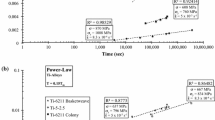Abstract
The effect of traces of Sb, Te and Cu on the creep of lead under various stresses (σ) atroom temperature is considered. The greatest sensitivity to the value of σ is exhibited by Pb itself, and the least by the Pb-Sb-Te-Cu alloy, in which the creep rate is low over a wide stress range. Tests on alloys treated in such a way as to produce the same grain size show that the addition of Sb, Te, and Cu reduces the creep rate of lead. The greatest influence is exerted by the addition of copper and the least by the addition of antimony. For all the materials studied the creep rate falls with increasing grain size. This influence is the greater, the lower the value of σ. For alloys annealed at the same temperature and possessing a grain size smaller than that of lead, in the case of small values of σ the beneficial effect of alloying is partly masked by the grain-size effect.
Similar content being viewed by others
Literature cited
G. A. Hiscock, J. Electrical,167, No. 5, 278 (1961).
E. N. de C. Andrade, in: Creep and Recovery [Russian translation], Metallurgizdat (1961).
A. Sally, Creep of Metals and Heat-Resistant Alloys [Russian translation], Oborongiz (1953).
L. M. T. Hopkins and C. J. Thwaites, J. Inst. Met.,82, 181 (1953–1954).
J. N. Greenwood and H. K. Worner, J. Inst. Met.,64, 135 (1939).
A. Latin, J. Inst. Met.,81, 529 (1952–1953).
G. B. Schanklin and J. F. Eckel, Electrical Engineering,73, No. 6, 523 (1954).
W. Hofmann and H. Malotki, Zs. Metallkunde,55, No. 3, 135 (1964).
J. N. Greenwood and J. H. Cole, Metallurgia, No. 39, 121 (1949).
G. R. Gohn, S. M. Arnold, and G. M. Bouton, Proc. Amer. Soc. Test. Mater.,46, 990 (1946).
V. A. Pereslegin, Za Kabel. Tekh., No. 3, 15 (1937).
E. N. de C. Andrade, Nature,162, 410 (1948).
G. B. Schanklin and J. F. Eckel, Trans. AIEE,74, 294 (1954).
M. A. Bol'shanina and T. F. Elsukova, Zavod. Lab., No. 3, 315 (1964).
E. R. Parker and G. Washburn, in: Creep and Recovery [Russian translation], Metallurgizdat (1961).
V. M. Rozenberg, Creep of Metals [in Russian], Metallurgiya (1967).
E. R. Parker, Trans. ASM,50, 52 (1958).
M. A. Bol'shanina and T. F. Elsukova, Izv. VUZ. Fiz., No. 12, 7 (1967).
Author information
Authors and Affiliations
Additional information
Translated from Izvestiya Vysshikh Uchebnykh Zavedenii, Fizika, Vol. 16, No. 9, pp. 77–81, September, 1973.
Rights and permissions
About this article
Cite this article
Elsukova, T.F., Bol'shanina, M.A., Makogon, M.B. et al. Creep of lead alloys. I. Soviet Physics Journal 16, 1254–1257 (1973). https://doi.org/10.1007/BF00890889
Received:
Issue Date:
DOI: https://doi.org/10.1007/BF00890889




